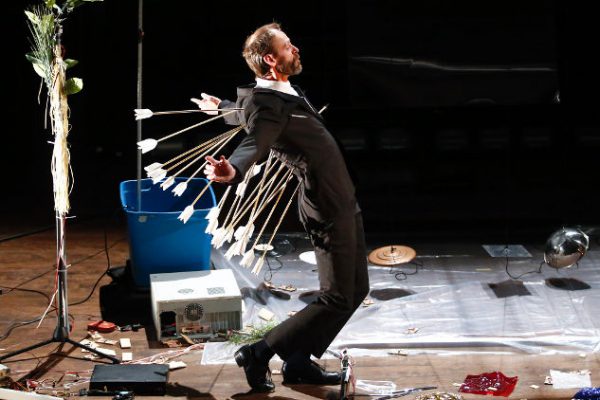It is opening night and the lobby of the Fei and MiltonWong Experimental Theatre is abuzz with chatter. We enter the state-of-the-art theatre and, to my surprise, there is a mini chamber orchestra onstage complete with acoustic instruments and electronic devices. One musician plays the Renaissance lute, while others play a drum, a xylophone and an oud (a pear-shaped instrument used in Middle Eastern and other cultures, the name is Arabic for “thin wood”). The show begins with a performer telling us a story in Spanish. She and two companions are all wearing what look like papier-mâché corsets moving onstage in a living, corporeal triptych. These costumes are elegant and whimsical–especially the high-neck, ruffed collars–reminiscent of those worn during the High Renaissance. Together, the women represent culture and wisdom.
All of a sudden, more dancers burst onstage and the empty space is now full of a dynamism and energy. Thirteen dancers form a circle, facing inwards. They slowly coalesce, moving as one organism. We hear the intricate rhythms of their feet–percussive, rigid, almost military in style. Then an unexpected change in mood occurs when the dancers begin to disrobe. The atmosphere becomes charged with an erotic, exotic playfulness. One male performer stands apart. He is the ringmaster or maestro, encouraging the group to explore their animal bodies.
Here Be Dragons is comprised of a highly talented, international ensemble of performers from Vancouver and Barcelona. As stated on choreographer Henry Daniel’s website, the methodology behind the production is to “design a new intellectual framework for research/creation in choreographic practice that deploys and foregrounds intersections of difference.” The project began with a formal information session and audition held at the School for Contemporary Arts at Simon Fraser University Woodwards in 2011, followed by subsequent workshops in both Vancouver and Barcelona and one performance entitled Barca: el otro lado (“the other side”) in December 2012 at the Institut del Teatre de Vic. This final full-length production, Here Be Dragons, is the culmination of these events and three years of creative, cross-cultural research.
Daniel gives his performers license to add their own stories, literally speaking about issues related to belonging, relationships and human exchange. At one point, dancer Kyle Toy talks about living in Alberta where everyone is either “one hundred percent Native or one hundred percent white.” Being of mixed blood, he is not as easily categorized so he was ridiculed and called names by his peers. Solo stories are weaved into larger statements about the ways humans relate. In this show, costume signifies gender: female performers wear leotards, shorts or skirts. The men wear black pants and white long-sleeved shirts. But Daniel is commenting not so much on gender difference as on the more complex world of cultural collisions and exchanges.
Here Be Dragons tackles what could be considered mankind’s most longstanding fascination: the desire to explore. And from this premise evolves a world of ever shifting, multiple points of contact, whether between people, artistic forms or aesthetics. The world we experience here is made of dance and music: minute gestures accompanied by a rich acoustic tapestry composed by Owen Underhill, one of Daniel’s key collaborators. Underhill’s playful respect for the polyrhythmic essentials of world music gives the show just enough variety and suspense. His composition contains both lyrical elements juxtaposed with tidbits of everyday sounds: a lion’s roar, splashing waves and drum beats pulsating along with the equally charged bodies onstage.
Two other distinct moments remain burned on my mind’s eye. In the first, the three Spanish women re-enter, this time they are naked. One wears a cone on her head. They act as a chorus, speaking at once, text overlapping. The corset is removed and placed in a spotlight. What does this piece of clothing represent? Sitting centre stage like an artifact, it conjures images of a former life, forgotten, perhaps family left behind while in search of a new world? The second moment is slightly comedic in nature. One performer tries to entice someone from the audience, playing the part of an immigrant seeking love. She asks: “Will you marry me? Are you illegal or legal?” Audiences laugh, but also absorb the critique. Living on the Pacific Rim–where the cosmopolitan demographic hails from the far reaches of the globe–the social commentary is not lost.
Opening nights of dance performances are often filled with raw energy and it is obvious that some of the transitions in Here Be Dragons are still being worked out. Given the show’s multidisciplinary format, the integration of each element into a seamless whole is a challenge. Despite the dynamic addition of video imagery and costume, at times there is so much happening that I find myself yearning for just the dance and the music. That said, Daniel is successful at capturing the curiosity and uneasiness that often arises when different cultures meet. I am inspired by each densely textured layer that seeks to ask questions rather than provide simple answers. Here Be Dragons is a complex work: intercultural in scope and multidisciplinary in form. After the show, I leave wondering about this phenomenon of human relations within our increasingly global world.
Henry Daniel is a man of many talents who trained with Joffrey Ballet School and The Alvin Ailey American Dance Centre. As Associate Professor at the School for the Contemporary Arts at Simon Fraser University, he is responsible for teaching, choreograph, and dance-based research. Here Be Dragons/Non Plus Ultra (further beyond) is the culmination of a larger, three-year long process of dance research–entitled PROJECT BARCA/Going East to find West/Going West to find Eas –funded by the Social Sciences and Humanities Research Council of Canada. Epic in scope, the process began officially in 2010 and engaged collaborators not normally associated directly with dance creation, including political science scholars and policymakers. The PROJECT BARCA site is a great place to get a better sense of the larger issues surrounding the work: www.projectbarca.blogspot.ca.
Tagged: Contemporary, Performance, BC






